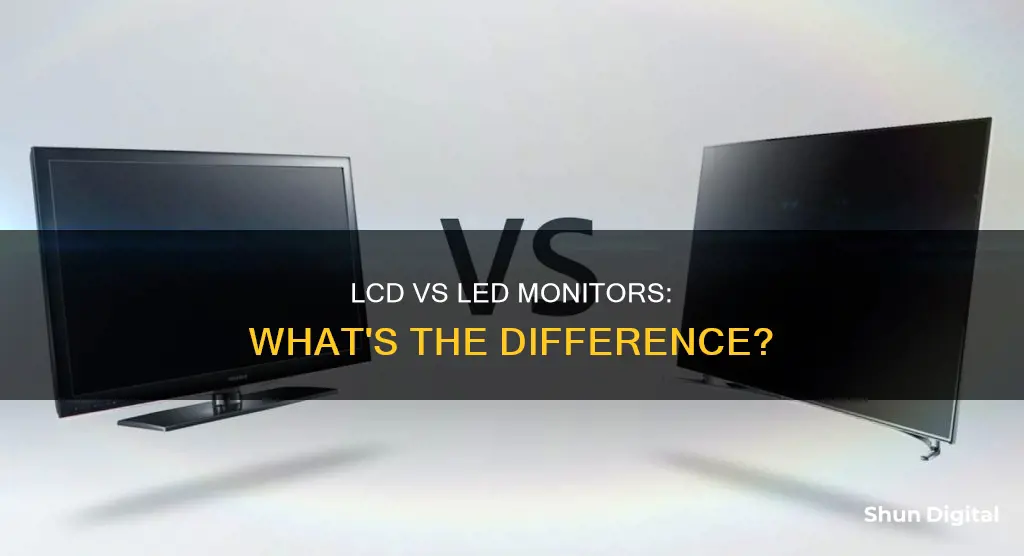
When it comes to monitors, there are two main types: LCD and LED. But what's the difference between the two? LCD stands for Liquid Crystal Display, and LED stands for Light-Emitting Diode. The main difference lies in their backlighting technology. LCD monitors typically use fluorescent backlights, while LED monitors use light-emitting diodes for backlights. Interestingly, all LED monitors are a type of LCD monitor, but not all LCD monitors are LEDs. This is because LEDs can be used to light LCD screens.
What You'll Learn

LCD monitors use cold cathode fluorescent lamps (CCFLs) for backlighting
LCD stands for Liquid Crystal Display. LCD monitors use cold cathode fluorescent lamps (CCFLs) for backlighting. CCFLs are long, thin tubes that produce light through the interaction of electricity with mercury vapour inside the tube. They are known for their long lifespan, high brightness, and low power consumption.
LCD monitors use liquid crystals, which are substances with properties of both liquids and solids, to create images on a screen. When an electric current is applied, the liquid crystals align to allow or block light, creating the images you see on the display. The liquid crystals cannot produce their own light, so they require illumination from an external source, which is where CCFL backlighting comes in.
CCFL backlighting provides a consistent and uniform light source, making it ideal for LCD monitors and televisions as it illuminates the entire screen evenly, ensuring clear and vibrant images. CCFLs are placed evenly behind the screen, delivering consistent lighting across the display so that all regions of the picture have similar brightness levels.
While CCFL backlighting used to be common in LCD monitors, nowadays, most modern LCD monitors are lit with LEDs. LED-lit LCD monitors are significantly thinner, lighter, and use less power than their CCFL predecessors. Additionally, LED diodes last longer than CCFL bulbs. The switch to LED backlighting has improved image quality and enhanced the evenness of screen lighting.
Understanding LCD and TFT Monitors: What's the Difference?
You may want to see also

LED monitors use light-emitting diodes for backlighting
LED monitors use light-emitting diodes (LEDs) for backlighting. This is a significant improvement over the cold cathode fluorescent lamps (CCFLs) used in traditional LCD monitors.
LED backlighting offers several advantages. Firstly, LEDs are much smaller, allowing for thinner and lighter monitors. They also last longer than CCFL bulbs and use less power, making them more energy-efficient and environmentally friendly. Additionally, LED backlighting provides more even lighting across the screen, improving image quality and visual clarity.
There are two main types of LED backlighting: full-array and edge lighting. Full-array backlighting involves placing LEDs evenly across the entire screen, allowing for local dimming and better contrast. This results in superior picture quality with deeper blacks and higher contrast ratios compared to standard LCD monitors. Edge lighting, on the other hand, places LEDs only along the edges of the screen, resulting in even thinner displays but with potentially less uniform lighting.
LED monitors also offer better colour accuracy, improved maintenance, and longer lifespans than traditional LCD monitors. They are a superior choice for activities such as gaming, graphic design, and video editing due to their faster response times, reduced motion blur, and improved dark scene performance.
While LED monitors provide many benefits, LCD monitors still have their advantages in certain situations. LCD monitors are often more affordable, making them a good choice for budget-conscious buyers. They also typically have matte screens, which reduce glare in bright environments, and emit less blue light, which can help reduce eye strain.
Positioning Monitors for Comfort: Aligning Different Sizes for Productivity
You may want to see also

LED monitors are more energy-efficient than LCD monitors
The constant need for the backlight to be on in LCD monitors, even when displaying dark images, makes them less energy-efficient than LED monitors, which can adjust their brightness based on the content displayed. This adaptability makes LED monitors more suitable for energy-saving applications, especially in environments where display brightness needs to be high.
On average, LED monitors consume about 20-30% less power than LCD monitors. LED monitors also tend to have better power management features, which can lead to lower electricity bills over time. Additionally, LED backlights typically last 50,000 to 100,000 hours, while CCFL backlights in LCDs last around 30,000 to 60,000 hours. This longer lifespan contributes to the overall energy efficiency of LED monitors.
While LCD monitors may be more affordable and offer more consistent lighting, LED monitors are the superior choice for energy-conscious consumers. LED monitors provide improved visual clarity, better colour accuracy, and superior picture quality with deeper blacks. They are also thinner, lighter, and have shorter response times than LCD monitors.
Widescreen Monitor Sizes: Understanding the Standard Dimensions
You may want to see also

LED monitors have a longer lifespan than LCD monitors
The longer lifespan of LED monitors is also attributed to their superior backlighting technology, which provides better colour accuracy, improved visual clarity, and enhanced energy efficiency. LED monitors consume about 20-30% less power than LCD monitors, which can lead to reduced electricity bills. Additionally, LED monitors offer a wider colour gamut, allowing them to display a larger percentage of the sRGB and Adobe RGB colour spaces. This makes them a preferred choice for professionals in graphic design, photo editing, and video production.
The higher durability of LED backlights also contributes to the longer lifespan of LED monitors. LED diodes last longer than CCFL bulbs, and the latest LED monitors feature mini-LEDs, which provide even finer lighting control. This advanced backlighting technology enables local dimming, resulting in improved picture quality and deeper blacks compared to LCD displays.
Furthermore, the overall construction of LED monitors contributes to their longer lifespan. LED monitors are designed with better cooling mechanisms, such as vents that allow heat to escape, reducing thermal stress on the display. This attention to architecture and construction ensures that LED monitors can withstand the impact of heat on their diodes, which is a significant factor in their longevity.
In summary, LED monitors surpass LCD monitors in terms of lifespan due to their advanced backlighting technology, superior image quality, enhanced energy efficiency, and improved overall construction. These advantages make LED monitors a more cost-effective and reliable choice in the long run, despite their typically higher initial price point.
Monitors: Choosing the Right Screen Size for You
You may want to see also

LCD monitors are more affordable than LED monitors
When it comes to choosing a monitor, there are a few key factors to consider, including purpose, budget, energy efficiency, picture quality, and screen size. If you're primarily looking for a monitor for general use or office work, either an LCD or an LED monitor can perform well. However, if you're looking for a monitor for gaming, graphic design, or video editing, an LED monitor is often the better choice due to its superior picture quality and colour accuracy. While LED monitors have many advantages, LCD monitors are generally more affordable and can be a good choice if you're on a tight budget.
LCD stands for Liquid Crystal Display, and this technology uses liquid crystals—substances with properties of both liquids and solids—to create images on a screen. When an electric current is applied, the liquid crystals align to allow or block light, forming the images we see on the display. LCD monitors typically use cold cathode fluorescent lamps (CCFLs) for backlighting and are thinner and more energy-efficient than older CRT monitors. They offer good colour reproduction and brightness but may struggle with producing true blacks.
On the other hand, LED stands for Light-Emitting Diode, and these monitors use light-emitting diodes for backlighting instead of traditional fluorescent lights. LED monitors offer superior picture quality with better contrast ratios and colour accuracy. They also have a longer lifespan than LCD monitors due to their more durable backlighting technology. LED backlights typically last 50,000 to 100,000 hours, while CCFL backlights in LCDs last around 30,000 to 60,000 hours. Additionally, LED monitors are more energy-efficient, consuming about 20-30% less power than LCD monitors, which can result in lower power consumption and reduced electricity bills over time.
While LED monitors offer many advantages, LCD monitors have their strengths too. LCD monitors are often more affordable, making them a cost-effective option for budget-conscious buyers. They also typically come with matte screens, which are effective at reducing glare in bright environments. LCD monitors usually have more uniform backlighting across the entire screen, and they emit less blue light, which can potentially reduce eye strain.
In summary, while LED monitors offer superior picture quality and improved performance, LCD monitors are more affordable and can be a good choice if you're on a tight budget or primarily need a monitor for general computing tasks.
Enabling Monitor Speakers on ASUS Devices: A Quick Guide
You may want to see also
Frequently asked questions
The main difference lies in their backlighting technology. LCD monitors use cold cathode fluorescent lamps (CCFLs) for backlighting, while LED monitors use light-emitting diodes.
Yes, all LED monitors are a type of LCD monitor. However, not all LCD monitors are LEDs.
LCD monitors are often more affordable, making them a good choice for budget-conscious buyers. They also usually come with matte screens, which are better at reducing glare.
LED monitors offer superior picture quality with better contrast ratios and colour accuracy. They are also thinner, more energy-efficient, and have a longer lifespan than LCD monitors.







